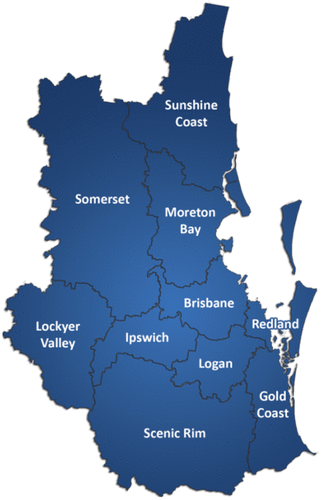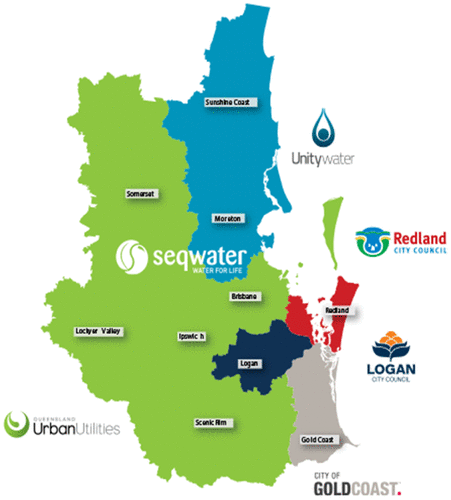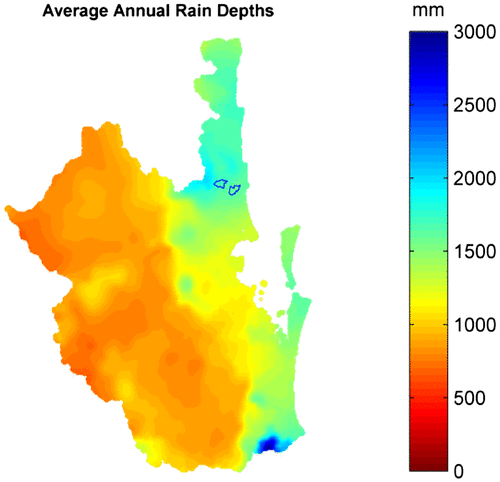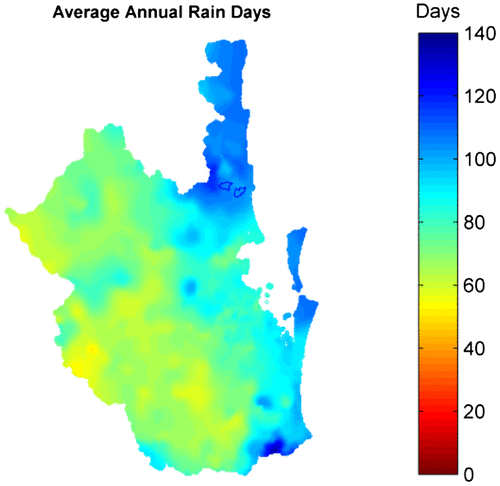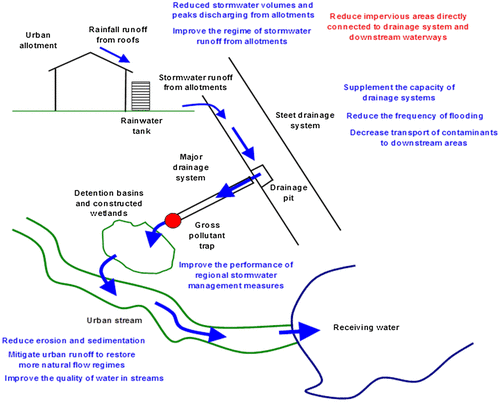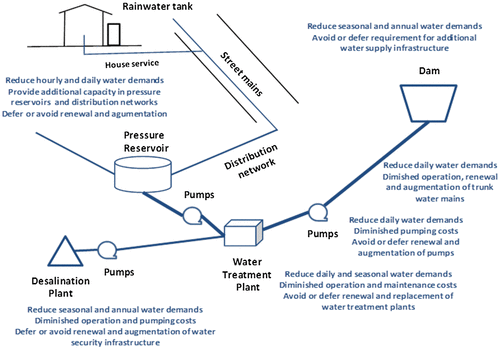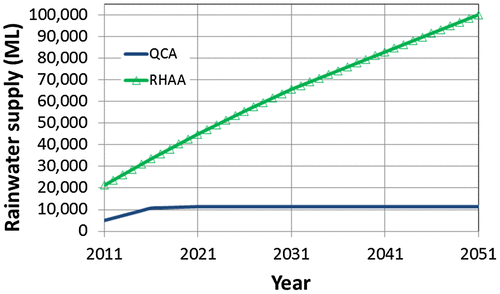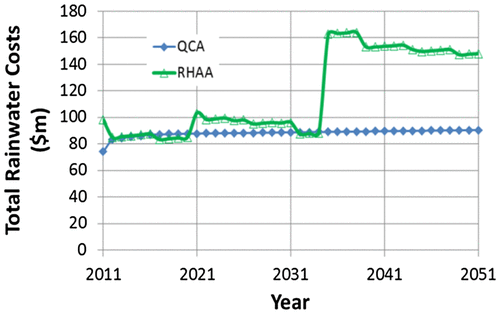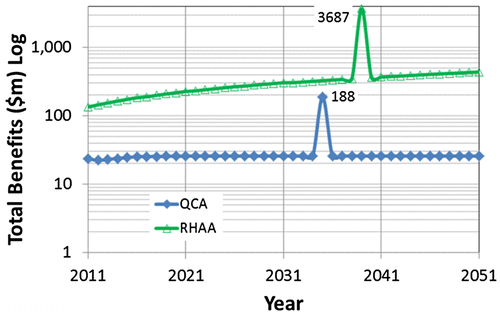Abstract
Over the last 30 years leading thinkers have taken us beyond mechanistic and reductionist analysis into systems theory and the critical boundary judgements that are fundamental to systems analysis. In defining and discussing boundary conditions, we also redefine values and facts imposed on hydrological and economic analysis that underpins decisions about government policy in water resources. The repeal of legislation for distributed interventions (water-efficient appliances and rainwater harvesting) that was previously enacted to improve the security of a regional water supply system is examined as a case study. The results of the analysis were defined by the costs and benefits that are inside or outside of the boundaries of legitimate and recognized consideration. This paper refers to those differences as boundary conditions and considers how those boundary conditions affect the outcome of analysis. Setting of boundary conditions (what is included, what is excluded and assumptions) in engineering and economic analysis dominates outcomes of decisions about government policy. These insights have general application to development of government water policy. The investigations outlined in this paper were combined to create an enhanced version of a systems analysis of a policy for setting targets for water savings on all new dwellings. It was established, using appropriate boundary conditions, that a 40% target for water savings is feasible for South East Queensland (SEQ) and provides a cost-benefit ratio of 2.1. These results indicate that a policy of mandating targets for sustainable buildings would provide substantial benefits to the state of Queensland, water utilities and citizens.
1. Introduction
Cities are subject to a continuum of change that is influenced by demographic, economic, political, environmental, cultural and social factors (Forrester Citation1969; Coombes, Want, and Colegate Citation2012). The evolution of a metropolis is also dependent on dominant influences in society and adherence to paradigms that transition over time (Kuhn Citation1962). There is change, towards more sustainable, inclusive and secure water futures, that is a driver for integrated and diverse water cycle strategies (PMSEIC Citation2007; Victorian Government Citation2013). These integrated strategies aim to provide multiple purpose outcomes that link environment, social and economic considerations across all scales of society. For example, decision-making for a strategy may incorporate a source of water that also manages stormwater runoff at distributed sources within urban areas to also improve the health of waterways and associated urban amenity (Coombes Citation2015). A supplementary approach to traditional centralized water sources aims to align the multiple benefits of local water cycle solutions with the challenges of evolving urban form in our cities.
The choice of water supplies to urban areas was historically based on single-purpose solutions that were derived and incrementally developed at a centralized scale to meet increasing local demands. Our intuitive short-term responses to urban challenges are based on long historical experience (Forrester Citation1969). These approaches may be ineffective or even detrimental when applied to a real complexity of future challenges presented by linked human and environmental systems (Forrester Citation1969; Meadows Citation1999). Growth of human civilization has increased the magnitude and complexities of interactions throughout society and the natural world with associated realization of uncertainties. Development of new policies for allocation of scarce resources requires knowledge of benefits and consequences across the dynamics of multiple scales and dimensions in urban and natural systems. Small shifts in a component of a system, such as human behaviour, urban form, climate or government policy, can generate unforeseen and substantial changes in an entire system (Meadows Citation1999). Adherence to established paradigms can limit the opportunity to foresee and adapt to a changing world (Kuhn Citation1962). The dynamics of human and linked environmental systems generate trade-offs in response to any proposed intervention (solution, strategy or policy) that may only be revealed using systems thinking and models of system dynamics (Forrester Citation1971; Meadows, Meadows, and Randers Citation1992; Kuczera and Coombes Citation2001; Coombes and Barry Citation2014). Solutions derived from simple deterministic analysis that only consider part of a system can produce unexpected and adverse outcomes across society (Forester, Citation1971; Meadows Citation1999; Midgley Citation2000).
Human systems operate within natural systems (Meadows, Meadows, and Randers Citation1992; Midgley Citation2000) that are altered by human interventions as a consequence of human dependency on ecosystem services (Carson Citation1962; Costanza et al. Citation1997). The need to integrate use of resources, government policy and associated environmental impacts in decision-making has been established by multiple authors (for example: Forrester Citation1969; Meadows, Meadows, and Randers Citation1992; Jakeman and Letcher Citation2003; Kuczera and Coombes Citation2001; Ulrich and Reynolds Citation2010; Coombes and Barry Citation2014). This involves interaction of multiple dimensions and scales to understand the trade-offs and opportunity costs of strategies or policies (Coombes Citation2005).
The term boundary conditions arises from a mathematical concept where a solution to a differential problem also satisfies a range of other conditions such as (for example) a temperature range or a time span. The application to mathematical and economic modelling is straightforward and boundary conditions can be modelled as constraints or as input scenarios in line with stipulated assumptions (Jakeman and Letcher, Citation2003). This concept has evolved in the systems literature to include boundary judgements about what is considered and not considered when analysing real-world systems. Boundary judgements are crucial to systems thinking to enable systems analysis to estimate the complex behaviours of real systems (Forrester Citation1969; Meadows, Meadows, and Randers Citation1992; Midgley Citation2000). The relationship between boundary judgements, facts and values is a triangular one, changing any one element changes the other two. This helps to explain why different interest groups not only disagree but may be unable to find common reference points (Ulrich Citation2000).
The implications for water management and associated engineering and economic analysis are highly relevant to modern Australia. Analysts can choose to include a wide range of criteria as either inside or outside the boundary of a systems view, including behaviour of consumers, resilience to climate change, stormwater management, flood control, energy use and community preferences. These decisions materially change the facts and values used by different parties to assess the outcome. Without clarity and discussion about boundary judgements the results of modelling may appear to be irrational to stakeholders using different boundary judgements and the perceived strategies available to society will be limited.
Decisions about policies that integrate different solutions, strategies or policies to meet multiple objectives encounter the complex politics of multilevel governance processes that foster powerful coalitions around paradigms that operate at different scales (Daniell et al. Citation2014). These processes are subject to disagreement between water utilities, communities, environmental managers, private firms, experts and all levels of government. This can be a driver of different claims, assumptions, values and expertise that are applied to analysis of policies and strategy. The often hidden transactions of a range of actors, with different perspectives, values and interests, in the process are key influences on decisions about alternative water cycle solutions, strategies and policies (Coombes, Want, and Colegate Citation2012).
In sectors that include government business enterprises with sole responsibility for a particular service, such as water and sewerage services, this can lead to a narrowing for considerations and an asymmetry of access to information in favour of these semi-private utilities or their government owners (Coombes, Want, and Colegate Citation2012). This situation can result in an optimization of the private costs and benefits relevant to service provided by the utility and exclusion from consideration of all other costs and benefits as external to the interests of the firm. The utility’s choice of solution may also limit (crowd out) opportunity for solutions originating from within society that may provide a wider range of benefits (Hubbard et al. Citation2015) and provide competition (ACCC Citation2015). These negative externalities are incorporated in society’s demand for a private good (water supply from the utility) and also increase the total costs incurred by society for consumption of the authority’s private good as shown in Figure .
Figure 1. The uncounted negative externalities of private production increases society costs and the addition of external solutions that account for negative externalities reduce society and private costs.
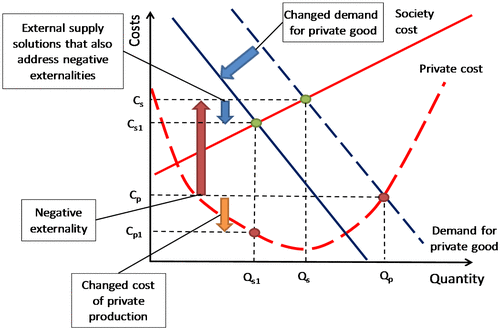
Figure describes an economic relationship for supply and demand for a private good (water services) and the associated impacts on society. The supply curve shows the total average cost of water services is a function of the quantity produced where the price of supply is regulated. These costs are a function of labour, energy, capital investment and other factors of production. The quantity of demand by consumers is a function of the regulated price of water and availability of alternatives.
Figure illustrates the problem of not counting externalities in an economic analysis. A negative externality, for example increased greenhouse gas emissions from a desalination plant or increased stormwater runoff, will increase the costs to the whole of society Cs above the private costs experienced by the utility Cp. These costs are invisible in analysis from the perspective of the utility and are borne by society. Introduction of additional supply solutions shifts the demand curve to the left and reduces demand for the private goods provided by the utility. For example, a rainwater harvesting system could reduce household water demand and stormwater runoff. The quantity of the utility’s private goods demanded by consumers may reduce from Qp to Qp1. The external supply solution, in this case, has also partially addressed the negative externality by generating less greenhouse gases and stormwater runoff from rainwater harvesting systems than the utility supply that includes desalination. This has reduced the cost to society from Cs to Cs1 and reduced the costs incurred by the utility from Cp to Cp1. It is possible that inclusion of externalities in economic analysis may improve the economic viability of the utility and decrease the costs accruing to society.
A narrowing of views due to the considerations of a utility or government department, engineering or economic assumptions, or due to the combined interactions of different participants with different agendas also sets the boundary conditions in analysis. These processes also limit the potential solutions that are considered in analysis (Kuczera and Coombes Citation2001). Decisions about solutions, strategies or policies for management of water cycle services will involve trade-offs between environmental benefits and lifecycle costs as shown in Figure . The optimum solutions available to society, from the perspective of environmental benefits and lifecycle costs, can be presented as the Pareto Frontier.
Figure 2. A narrow focus on solutions provides a constrained solution space and Pareto Frontier whilst the whole of society solution space provides a more optimum Pareto Frontier.
Figure highlights the high price (such as increased lifecycle costs and decreased environmental benefits) of boundary conditions that act to constrain the solutions available to society. A constrained solution space and Pareto Frontier occurs when institutional constraints, normative values and assumptions exclude the critical evaluation of all feasible solutions.
Systems analysis techniques can explore the sensitivities and uncertainties created by boundary conditions and assumptions imposed by stakeholders and analysts. These considerations are different to uncertainties created by quality of input data to models and a model approximation of a complex natural system. Economic analysis of potential solutions should include investigation of the impact of discount rates to avoid excessive discount rates which discriminate against solutions with higher initial investment costs and long-term benefits or penalize solutions that provide future benefits (Coombes, Citation2007). However, the additional sensitivities and uncertainties created by imposed boundary conditions also need to be considered to understand the trade-offs or choices in society. These issues are explored in this paper using a single case study that includes two completing economic studies that were used to develop a comparative analysis.
This paper investigates the repeal of legislation for sustainable buildings (SB) in SEQ as a case study. The influence of assumptions and boundary conditions in engineering and economic analysis on decisions about government policy is examined using published reports and systems analysis of the SEQ region. Detailed discussion about engineering and economic models is not addressed in this paper. Publications by Coombes and Barry (Citation2015), Coombes (Citation2015) and Coombes (Citation2013) provide additional detailed information about systems analysis of water cycle systems that support this investigation. The primary focus of this paper is investigation of the ‘hidden’ assumptions and boundary conditions imposed on analysis that change government policy. Whilst this case study is about water-efficient appliances and rainwater harvesting, the insights for impacts of assumptions on government policy have more general application.
Section 2 provides the background to this investigation, while Section 3 discusses the appropriateness of different boundary conditions for economic analysis of water cycle systems that includes solutions at multiple scales. This includes considering the urban water cycle (water supply, wastewater disposal, stormwater management and protection of the environment) as a linked system that operates at different scales and timeframes (Coombes and Barry Citation2014). It is also crucial to count a larger range of costs and benefits in the analysis (Coombes Citation2013). The second set of boundary conditions is defined in the economic assessment of managing distributed transactions, particularly the operational cost of water delivery, security of water supply, stormwater quality and flooding. These issues are addressed in a case study in Section 4 which deconstructs the analysis underpinning the repeal of the mandatory provisions MP 4.2 legislation for SBs in Queensland. Finally, these insights are combined with the latest audited economic reports (National Performance Reports, Queensland Competition Authority (QCA) assessments, Annual Reports of water utilities and town planning projections) in a detailed systems analysis of water resources and associated economics that is presented in Section 4, as a comparison between Business as Usual (BAU) and SB options.
2. Background
SEQ in Australia has a population of over 3.2 million people and is served by 10 local government authorities (see Figure ) and 6 water utilities (see Figure ).
Figure shows that SEQ is serviced by a bulk water authority Seqwater. Five distribution and retail water authorities provide water, recycled water and wastewater services, namely Queensland Urban Utilities (QUU), Unity Water (UW), City of Gold Coast, Logan City Council and Redland City Council. Stormwater management provided by the local government authorities is shown in Figure . The region experiences annual population growth of over 1.9% and is expected to accommodate 4.1–5.1 million people by 2031 (Queensland Treasury and Trade Citation2012). More than 19,000 new dwellings are constructed each year.
The main source of water for the region is from water stored in large dams supplied by river systems. Water is released from these regional storages to water treatment plants, treated to drinking water standard and pumped to service reservoirs throughout urban areas. Drinking water is then distributed to dwellings and businesses under pressure via a network of water pipes. Management of this infrastructure, treatment facilities and distribution processes results in capital and operational costs to water utilities that are passed onto consumers as fixed and variable service fees. A majority of water use in dwellings is for drinking, bathing, toilet flushing, clothes washing, cleaning and for irrigation of gardens. Some water is removed from the system for drinking, kitchen and garden uses but most of the water supply demanded by residents is discharged as wastewater. Wastewater is discharged from dwellings and businesses via gravity to a network of sewage pipes that flow to pumping stations that transfer wastewater to treatment plants for treatment and release into receiving waters. There is substantial leakage of groundwater and stormwater runoff into the wastewater networks (wastewater networks are designed for wet weather factors of 2 to greater than 12). Consumers pay fixed fees to water utilities for wastewater services.
Stormwater is managed by local government in a process that is not usually integrated with the management of water and wastewater. Stormwater runoff from properties is collected and transported in drainage networks of stormwater pipes to local waterways. The quantity of stormwater runoff is managed using regional detention basins, whilst urban stormwater pollution is mitigated using bioretention measures and constructed wetlands. Stormwater services are not purchased or consumed, but are provided by government to protect the community and the local environment. SEQ has a variable climate with significant variations in rainfall which creates both droughts and floods. Security of water supplies, flooding and the ecological health of waterways are significant management issues. The region also experiences spatial variation in average annual rainfall depths (Figure ) and frequency (Figure ) which impacts on the behaviour of water, sewage and stormwater systems.
Figure demonstrates that the region is subject to relatively high average annual rainfall depths (900–2000 mm) and high average annual frequency of days with rainfall (50–130 days). On average, the region will generate substantial volumes of stormwater runoff, including rainfall runoff from roofs, which are managed by local government. Stormwater management is a challenge for the region due to high-intensity rainfall events and increasing urbanized areas that drive flood risks. The need to manage urban stormwater pollution is also a substantial issue for protection of the amenity and environmental values provided by the local waterways. Morton Bay is the receiving environment for urban stormwater runoff and is recognized by RAMSAR as an internationally significant ecosystem.
The prices charged by the state-owned water monopolies are regulated by the QCA who act to ensure monopoly businesses operating in Queensland do not abuse their market power through unfair pricing or restrictive access arrangements. Water pricing is applied at the same rate for a geographic area of a water utility and is not varied by the cost of supply, transport or treatment to deliver the water or manage wastewater. However, the characteristics and behaviour of cities are subject to strong spatial and temporal variation that needs to be included in analysis of the economics of water and wastewater services (Coombes and Barry Citation2014). Considerable spatial and temporal variation in climate, stormwater runoff, water use behaviours and costs of water and wastewater services were observed throughout urban regions. During the recent drought, water volumes in the region’s major storage Lake Wivenhoe declined to 15% of capacity. This event prompted the establishment of the SEQ Water Grid which included the connection of the water supplies of 12 dams in the region, construction of the Tugun desalination plant and the Western Corridor recycled water scheme. In addition, the Queensland Development Commission (QDC) created mandatory provisions for water savings targets (MP4.2; QDC Citation2008) for residential buildings and for alternative water sources in commercial buildings (MP4.3; QDC Citation2009). These provisions utilize rainwater harvesting, grey water schemes and water-efficient appliances.
An independent audit and monitoring of water use behaviours throughout SEQ revealed that dwellings with water-efficient appliances that utilized rainwater for indoor and outdoor uses exceeded the requirements of Queensland Development Code MP 4.2 (Coombes Citation2012b). Water-efficient dwellings using rainwater for outdoor uses provided average annual reductions in demand for mains water of 48 kL and dwellings using rainwater for indoor and outdoor uses provided average annual reductions in mains water demands of 90 kL. Relatively small rainwater tanks (2 m3) and roof areas (50–100 m2) generated the substantial reductions in mains water demands. Use of rainwater for indoor uses reduced peak daily and hourly mains water demands which diminishes impacts on and requirement for water distribution, pumping and treatment infrastructure. The observed change in frequency and magnitude of household water use events is demonstrated by the comparison between a households with water-efficient appliances and rainwater harvesting (Figure ) and households that do not include rainwater harvesting (Figure ).
Figure 7. Frequency and magnitude of mains water demands in dwellings with rainwater harvesting and water-efficient appliances.

Figure 8. Frequency and magnitude of mains water demands in dwellings without rainwater harvesting and water-efficient appliances.
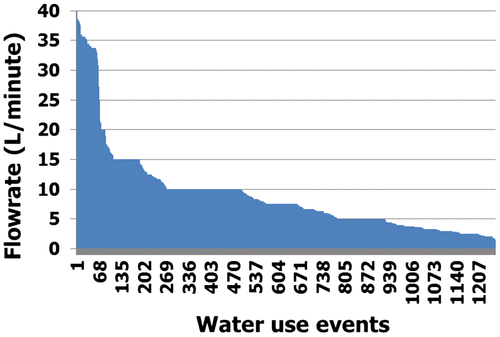
Figure reveals that water-efficient dwellings with rainwater harvesting provide large reductions in the frequency and magnitude of demands for mains water which will impact on the costs of providing and operating water infrastructure (Coombes Citation2012b). Similarly, long-term monitoring of households with rainwater harvesting and water-efficient appliances by Coombes and Downs (Citation2015) revealed 61% reductions in water demands and 21% decrease in stormwater runoff. Peak demands and stormwater discharges were reduced by 61% and 11%, respectively. These observations were consistent with the analysis by Lucas, Coombes and Sharma (Citation2010) of the impact of demand management and rainwater harvesting on the design of local water distribution networks. The changes in household mains water use patterns directly impacts on network dynamics. Demand management and rainwater tanks impact upon the diurnal patterns of water flows in a water supply network and can significantly reduce peak mains water demands. This outcome provides reductions in water infrastructure costs by up to 53% or $2010 per dwelling. In addition, Coombes (Citation2007) found that widespread installation of rainwater harvesting at residential dwellings generates net present value savings in the provision and operation of large-scale water infrastructure, for the period 2010–2050, ranging from $57 to $6371 for each dwelling with a rainwater harvesting system. Building scale solutions can provide substantial improvements in the security of urban water supplies that defer requirement for augmentation (Coombes et al. Citation2002; Coombes Citation2005; Coombes and Barry Citation2014).
The New South Wales government has determined that the BASIX legislation mandating 40% reductions in household water use will provide cumulative reductions in mains water use of over 300 GL and in greenhouse gas emissions of over 102 million tonnes at a net present value of $843 million to 1.2 billion, for the period 2010–2050 (NERA Citation2010). A majority of these benefits are provided by water-efficient appliances and rainwater harvesting. Observations from National Performance Reports for Urban Water Utilities (NWC Citation2012; BOM Citation2015) were examined to determine the historical impact of SBs on the operating costs of water utilities. The water operating costs for utilities subject to BASIX performance targets for SBs (Sydney Water and Hunter Water) is compared to the water operating costs of utilities (City West Water, South East Water and Yarra Valley Water) that operate in jurisdictions without targets for SBs in Figure .
Figure 9. Water operating costs for utilities operating with mandates for sustainable buildings (SBs) vs. costs of utilities without mandates for SBs (NWC, Citation2012; BOM, Citation2015).
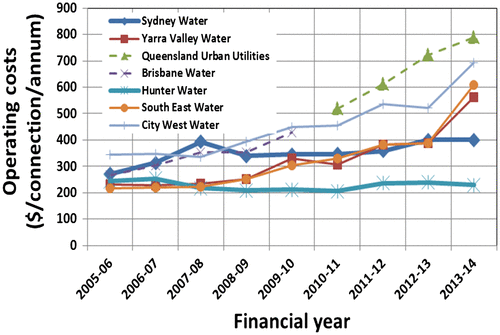
Figure shows that growth in water operating costs of utilities in jurisdictions with BASIX legislation has significantly reduced in comparison to water operating costs of utilities in areas without mandates for SBs. A combination of water operating costs from Brisbane Water and then QUU in SEQ is an interesting contrast. The establishment of mandatory provisions for SBs in 2008 contributed to a decline in the growth in operating costs but the high costs of the operation of the water grid with desalination and the Western Corridor scheme (WCS) ($3512/ML) from 2009, as shown in Figure , resulted in an escalation in operating costs.
Figure 10. Operation of desalination and Western Corridor scheme with costs (NWC, Citation2011).
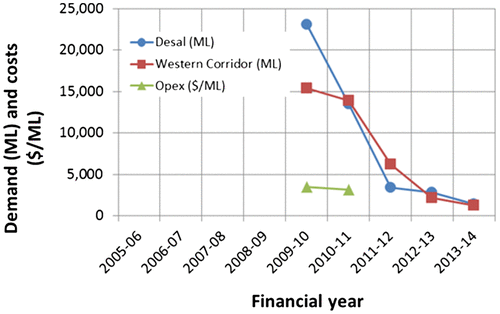
Figure highlights that the maximum utilization of desalination and the WCS was during the period 2009–2011 which declined to minimal use in 2013. The growth in water operating costs for SEQ was impacted by mandates for water savings in buildings (2008–2012), the operation of the water grid (from 2009) and the repeal of the mandates for water savings in buildings (from 2012). These competing processes have the effect of obscuring the reduced operating costs generated by the mandatory provisions for SBs and only 32% of SBs utilized rainwater for indoor uses (ABS Citation2013). It is proposed the mandatory provisions impeded a more rapid growth in operating costs. Implementation of a planning policy for SBs with similar governance to BASIX is likely to achieve greater benefits.
In 2012, the Queensland government formed a view that the costs of the mandatory provisions for SBs (MP 4.2 and MP 4.3) were greater than the benefits and requested that the economic regulator QCA conduct a review. The assessment by the QCA considered submissions from other government departments but was almost solely reliant on analysis by a consultant (MJA Citation2012) – hereafter referred to as the QCA analysis – and did not substantially consider other submissions in agreeing to the repeal of the mandatory provisions for SBs. In part, the philosophy of the economic assessment was that regulation or performance targets impedes the operation of the ‘free market’ and legislated performance targets need to be dismissed as ‘red tape’. However, perfect markets with adequate access, knowledge and competition may only exist in text books, elsewhere regulations need to be applied to force imperfect markets to generate acceptable economic behaviours from the perspective of the whole of society.
Free market forces and competition do not apply to water and wastewater services that are managed by the bureaucracy as government-owned monopolies (ACCC, Citation2015).Footnote1 Stormwater services are managed by local government and are also not provided via market mechanisms. The implication is that the market forces, which are expected to drive efficiency and productivity, are not operating. In addition, markets are strongly dependent on local and distributed transactions that may not be captured in a centralized average analysis of water options. Water services are essentially a transport business with cumulative impacts and costs (Coombes Citation2013; Coombes and Barry Citation2014). A highly treated, monitored and heavy commodity is provided on demand direct to the user through large, single-purpose infrastructure over a considerable distance from source to local demand (Kuczera and Coombes Citation2001). This process is repeated in reverse for wastewater. A third set of infrastructure is required for stormwater management. Such a business is expensive to operate and reductions in the volume of water that needs to be centrally managed and transferred to users, across substantial distances, results in significant savings that were not considered by the QCA. Similarly, planning for water security in SEQ is almost entirely reliant on desalination and large-scale recycling schemes to meet future water demand. Full use of the water grid is implied when demand reaches 545 ML/day and supply augmentation is not expected until after water demands reach 585 ML/day (QWC Citation2010) but the high capital and operating costs of these additional supplies should be included in any regional analysis.
3. Appropriate boundary conditions for economic analysis
Exploring and understanding the economic, social and environmental trade-offs resulting from policy decisions (choices) about scarce resources is an important activity in society that impacts on households, firms, the environment and governments (Hubbard et al. Citation2015). These decision-making activities are subject to a wide range of competing processes, as outlined in the Introduction of this paper. New solutions, strategies and policies seek to find the best places to intervene in a particular system to solve emerging problems or to produce improved outcomes for society. Investigations of potential solutions are driven by legacy knowledge that some small changes to particular activities at leverage points within a system (households, firms, cities, economy and environment) can create substantial overall benefits to society (Meadows Citation1999). These interventions can act to multiply the economic effects of a policy and can stabilize undesirable economic processes (Keynes Citation1936; Gordon Citation1990).
Economic decisions can create winners and losers. This generates a range of competing values that are often assigned to definition of a system and the potential intervention which can produce undesirable outcomes (Forrester Citation1969; Ulrich Citation2000; Midgley Citation2000; Jakeman and Letcher Citation2003; Daniell et al. Citation2014). The responses of complex systems to interventions are often unknown and are unlikely to be understood without systems analysis that utilizes the best available knowledge across as much of the connected system as practicable (including water, sewerage, stormwater, urban form and amenity, environment and economic systems) to reveal the future consequences of a decision (Forrester Citation1969; Meadows, Meadows, and Randers Citation1992; Jakeman and Letcher Citation2003; Beven and Alcock Citation2012). Complex systems, and the leverage points that change them, are often counterintuitive (Forrester Citation1971). However, many current paradigms of thought remain based on intuition and often unstated assumptions.
For example, a widely accepted and commercial paradigm is to consider aspects of complex systems in isolation, reducing behaviour and outputs to one or two algorithms and dismissing additional system impacts as externalities. Water management in such a paradigm is conceptualized and practiced as a mechanism that is observable, factual and predictable (Midgley, Citation2000). Aspects of water management are considered in isolation of the other processes around them. This type of analysis may identify useful solutions. However, the history of the twentieth century has shown that the world is not predictable – concepts such as complexity, chaos and ‘knowledge vs. reality’ have led to a questioning of mechanistic assumptions. If we want to consider the full range of solutions and maximize the benefit of our interventions, we need to consider water management as a system and make a series of judgements about the conditions and boundaries of that system (Ulrich and Reynolds Citation2010). Intuitively this makes sense, water management impacts almost every facet of life in urban regions and beyond, and thus a mechanistic and reductionist analysis will not begin to evaluate the potential richness of different management strategies.
Predictions of the behaviour of a water cycle system that is subject to a future intervention are uncertain due to variability of natural systems and difference sources of information. Development of policies and decision-making should incorporate these uncertainties in model predictions of the consequences of decision options (Beven and Alcock Citation2012). Concerns about natural uncertainties of real-world systems have led to discussion that management decisions should not be based on predictions of future outcomes and should be limited political to and social process of seeking consensus about potential action options (Funtowicz and Ravetz Citation1990; Brown, Keath, and Wong Citation2008; Daniell et al. Citation2014). However, many authors including Forrester (Citation1969, Citation1971) and Xu et al. (Citation2009) highlight that the potential consequences or trade-offs of decisions across social, economic and environmental considerations cannot be understood without systems models.
Systems analysis is needed to integrate the multiple issues, different values and knowledge of stakeholders in the decision-making process (Jakeman and Letcher Citation2003; Beven and Alcock Citation2012). The essential process of incorporating all available and validated information in a systems analysis can also reveal the normative values of coalitions of interest (Daniell et al. Citation2014) and the stakeholders who are advantaged due to asymmetry of information (control of knowledge and data) (Coombes, Want, and Colegate Citation2012). This is consistent with observations of Kuhn (Citation1962) that the different paradigms (or views) of various stakeholders can be changed by informed discussion of the consequences and the opportunity of an improved paradigm (Meadows Citation1999). It is beholden on the systems analyst to endeavour to include as much available information as possible and to ensure that the analysis is not artificially constrained by much more restrictive boundary conditions imposed by stakeholders or experts. This approach is outlined below using the example of the Queensland repeal of legislation supporting SBs. The next part of this Section (3.1) looks generally at boundary conditions related to economic analysis of SBs in water cycle systems generally. Section 4 then looks specifically at comparative economic analyses linked to Queensland SBs to uncover and discuss the appropriateness of choices of boundary conditions, one set of which provided evidence for the repeal of legislation to support their development.
3.1. Understanding boundary conditions of economic analysis of SBs in water cycle systems
Distributed local options, such as SBs, are installed and operate throughout existing centralized water cycle systems to modify the cumulative demand for traditional services and improve the behaviour of a more diverse water system (Coombes et al. Citation2002; Coombes Citation2005). Analysis of the impact of distributed options within centralized systems requires adequate detail to capture the variable changes in behaviour that are driven by spatial and temporal variations in climate, demographic, socio-economic, topographic, ecological and infrastructure considerations. The behaviour of an alternative (such as SBs) option must be compared to a credible definition of the BAU option that includes sufficient detail to allow comparison to the proposed alternative option. Importantly, the analysis must include the alternative option, strategy or policy as part of the existing (BAU) system rather than an isolated or separate assessment of alternative options. Comparison of a SBs option that includes rainwater harvesting and water-efficient appliances requires definition of the BAU option for the region with a high level of spatial and temporal detail to accommodate the smaller scale of the intervention. In addition, it is essential to understand that the BAU option will already include some elements of the alternative option. It is often the case that a system response is driven by a change in the rate of adoption of the alternative options within a BAU system over time.
A systems analysis examines the movement and storage of water from sources (extraction from waterways) to sinks (disposal to waterways). The transactions throughout the system include the costs of operation, replacement and provision of infrastructure that are dependent on demand for a service, which can be defined as volumes of water or magnitude of energy. Mandating SBs will generate an additional cost to the homeowner of installing, operating and replacing rainwater harvesting systems and water or energy efficient appliances. This includes installation of rainwater storages, leaf diverters, first flush diverters, pumps, filters, more efficient appliances and plumbing connections. The operation of this system will require periodic replacement of components in accordance with expected design lives (for example; water-efficient washing machines and rainwater pumps have a design life of about 10 years and a rainwater storage has a design life of about 30 years).
There will be reductions in average and peak water demands from the centralized system that results from more efficient water uses and substitution of mains water demand by use of rainwater. Reductions in mains water demands in buildings will decrease revenue from provision of water and wastewater services, and provide offsetting reductions in operating and capital expenses to water utilities. The extent of the diminished revenue for water and sewage services is dependent on the regulated tariff structure – for example, the proportion of fixed charges determines the relative magnitude of any reduced revenue. Similarly, the magnitude of reduced operating costs is driven by cumulative impacts throughout a region. It is also necessary to consider the longer term impacts of strategies. For example, an overview of the integration of local rainwater harvesting on the urban stormwater system is shown in Figure .
The volumes of stormwater runoff are reduced and quality of urban stormwater is improved by retention of roof runoff in rainwater harvesting systems (Walsh Citation2004; Poelsma, Fletcher, and Burns Citation2013). The operational and capital costs of managing stormwater quality onsite, in downstream constructed wetlands and treatment systems are reduced and deferred. This improves the health and amenity of local waterways and receiving waters. Reductions in stormwater runoff volumes decrease the risks of local flooding in drainage networks, flood management facilities and waterways. This can lead to reduction in the volume of infrastructure required for flood management. The operational and capital costs of flood reduction infrastructure can be reduced and deferred.
Reduction in demands for mains water also has longer term impacts. In the medium term the operational and replacement costs of water treatment plants, pumps and pipelines decrease. Reductions in peak demands reduce the maximum capacity requirements of the water network to supply services. These reductions in costs are cumulative throughout water cycle networks and increase over time. In the longer term, the capital costs of building new pressure service reservoirs, higher capacity networks and larger treatment plants are deferred or avoided by reducing the cumulative volume of demands. This has a secondary impact of avoiding the higher operational costs of larger infrastructure such as desalination plants and regional recycled water schemes. It is essential to include all connected elements of the water and energy cycle in analysis. An overview of the interaction of local rainwater harvesting on the urban water supply systems is shown in Figure .
4. Comparison of key assumptions from a case study
During 2012, the Queensland government repealed legislation (QDC MP 4.2 and QDC MP 4.3) that mandated SBs. This decision resulted from analysis by the QCA (Citation2012) with inputs from consultants (MJA Citation2012) that found the costs of the legislation were greater than the benefits. The QCA analysis is compared to the systems analysis by RHAA (Coombes Citation2012a) to prompt discussion about appropriate boundary conditions and economic processes for assessment of benefits of distributed solutions. A review of the QCA and RHAA reports revealed that different information was provided about economic analysis and assumptions which created difficulty in the comparison. Additional information was requested from the consultants and from the Queensland government to clarify the QCA analysis. In the absence of the requested additional information, the authors were able to reconstruct the QCA analysis using only the information provided in the various reports (MJA Citation2012; QCA Citation2012) as shown in Tables and .
Table 1. Summary of key assumptions about costs of rainwater harvesting.
Table 2. Summary of key assumptions about the benefits of rainwater harvesting.
The QCA and the RHAA utilized different discount rates and planning horizons. The key assumptions in both reports are summarized in Table for the costs of rainwater harvesting and in Table for the benefits of rainwater harvesting. These assumptions listed in Tables and were combined with the results of each report to create a comparable economic analysis.
Different modelling philosophies were also employed with the QCA focused on a Cost-Benefit Analysis and the RHAA utilized a regional water balance methodology that also incorporated an economic analysis. Nevertheless, this discussion is concerned with the impacts of input assumptions and processes on the outputs of analysis and does not focus on the detail of water resources modelling. However, there were some similarities in the structure of the analysis – both the QCA and RHAA analysed the SEQ region as a single node using inputs from other studies (QCA) or a regional water balance model (RHAA) to define inputs about distributed rainwater harvesting.
Tables and reveal that sufficient information was available to allow reconstruction of both analyses into timelines of rainwater savings, costs and benefits that are discussed in detail in the following Sections. The RHAA analysis was altered to incorporate a 4.4% discount rate and a 40-year planning horizon to provide comparable outputs in the same categories as the QCA analysis. A comparison between the cumulative savings from the QCA and the RHAA are presented in Figure .
Figure demonstrates a substantial difference between water savings used in the QCA and RHAA reports. The assumption by the QCA that pumps and rainwater tanks are not replaced at the end of their useful life creates a flat water saving regime after 2017 and dominates the difference in water savings. Cumulative water savings are also impacted by assumptions about the number of rainwater harvesting systems installed prior to 2011 and by a focus by RHAA on SBs which also include water-efficient appliances. The timelines of costs and benefits resulting from the different reports are provided in Figures and , respectively.
Figure shows that the timelines of total rainwater costs in the QCA analysis are lower than the RHAA timeline of costs. These differences are driven by the QCA assumption that all pumps and rainwater tanks are not replaced and fail at the end of their asset life, use of higher installation costs and fixed annual installation numbers. In contrast, the variability of the RHAA timeline of total costs is driven by population projections, assumed periodic replacement of all pumps and rainwater tanks, and historical installation rates of sustainable dwellings prior to 2011. Another key difference is that the QCA assume no rainwater harvesting systems prior to 2007 and the RHAA assume 108,400 sustainable dwellings in 2007 in accordance with observations of the Australian Bureau of Statistics (ABS Citation2013).
Figure reveals considerable differences in the timelines of benefits derived from the QCA and RHAA analysis. The QCA assumption that all rainwater harvesting systems cease working after 10 years (pumps and rainwater tanks are not replaced), lower values for deferred operational costs of supplying water and smaller values for deferred augmentation has resulted in a constant and smaller annual benefit from rainwater harvesting. Note that the spikes in the benefit timelines represent the actual future value of deferred augmentation that was deconstructed from the net present values in the reports. A comparison of the benefits and costs of the different analysis is presented in Tables and respectively.
Table 3. Comparison of present value of benefits from QCA and RHAA analysis.
Table 4. Comparison of present value of costs from QCA and RHAA analysis.
The results in Tables and reveal substantial differences between the QCA and RHAA analysis that would justify vastly different policy decisions. A cost-benefit ratio of 0.32 from the QCA would drive rejection of a policy and the ratio of 2.1 from RHAA would prompt acceptance based on economic criteria. It is noted that both the costs and benefits of the RHAA analysis are substantially higher than the QCA analysis. The sensitivity of the economic analysis to changes in discount rates was tested using discount rates of 0% and 9% as shown in Table .
Table 5. Sensitivity of cost-benefit ratios.
Table reveals that the QCA analysis is almost insensitive to selection of discount rates. In contrast, the RHAA investigation was responsive to selection of discount rates and provided higher cost-benefit ratios for low and high discount rates. A traditional sensitivity analysis of discount rates reveals that the imposition of narrow boundary conditions on analysis produced results that were insensitive to discount rates and analysis that is more inclusive of effects on linked components of the system displays sensitivity to discount rates. The impact of boundary conditions imposed on investigations is thus substantially more significant than the effect of discount rates. These differences in the comparison warranted further discussion as outlined below.
4.1. SBs and installation costs
The RHAA analysis is based on population projections provided by SEQ Water Strategy (QWC Citation2010), analysis using a regional water balance and performance of SBs (water-efficient appliances and rainwater harvesting) in accordance with the MP 4.2 legislation. Annual water savings of 90 kL (average savings: rainwater 59 kL; water-efficient appliances: 31 kL) were assigned to each SB in accordance with monitoring results for SEQ from Coombes (Citation2012b). This analysis assumed that all new dwellings will be SBs. A total of 875,962 SBs were established between 2011 and 2051 that generated annual water savings of 78,837 ML in 2051 at a net present cost of $1831 m.
In contrast, QCA focused on rainwater harvesting systems installed in new dwellings or buildings in response to the MP 4.2 and MP 4.3 legislation, utilized a fixed average number of new rainwater harvesting systems in each year and assumed an annual rainwater supply of 50 kL to each system. This analysis was completed as an accounting process that was not linked to the SEQ water balance or planning projections for the region. Table in the QCA report (MJA, Citation2012) presents net present capital costs of rainwater harvesting systems of $1645 million and a net present cost of $4861 per rainwater harvesting system. These results imply that 338,500 rainwater harvesting systems were installed over a 40-year period but 875,962 new homes were projected. The total water savings generated by rainwater harvesting was not reported.
Table 6. Comparison of benefits from BAU and Sustainable Building (SB) options.
The report associated with QCA analysis appeared to incorporate 537,462 fewer rainwater harvesting systems than the RHAA investigation at a higher cost. Nevertheless, the Queensland Treasury and Trade (Citation2012) estimate that over 18,000 new dwellings in each year are constructed in SEQ and ABS (Citation2013) found that 55,128–32,204 rainwater harvesting systems were installed in each year during the operation of the MP 4.2 legislation. It would appear that the QCA has assumed low installation rates. However, our reconstruction of the analysis using details provided in the above Table indicates that 878,960 rainwater harvesting systems were included in the QCA investigation. These results indicated that the actual net present capital cost of a rainwater harvesting system should have been reported as $1,524 by the QCA rather than the value of $4,861.
4.2. Avoided water operating costs
There are substantial differences in the magnitude of avoided water operating costs between the RHAA (NPV of $3436 m) and QCA (NPV of $129.3 m), which indicate substantial differences in assumptions and boundary conditions employed in the analysis. The RHAA used the water operating cost of $3493/ML that was derived from the National Performance Reports (NWC, Citation2012) for QUU. The RHAA analysis commences with 236,000 SBs with annual reductions in mains water demand of 21,240 ML in 2011 and finishes with annual reductions in mains water demand of 107,142 ML in 2051. It was also assumed that all rainwater pumps were replaced after 15 years (this includes a warranty period of 5 years for pumps) and all rainwater tanks were replaced after 25 years operation. By way of comparison, in 2015 the Australian Bureau of Statistics (ABS, Citation2015) commenced a process of estimating household rainwater harvesting water consumption and values for states and territories including Queensland. The ABS estimated that rainwater harvesting made up 11,900 ML of household consumption in Brisbane (which has a smaller population than SEQ) during the 2013/2014 financial year. Whilst the ABS estimation was for a much smaller area they provide independent verification of the order of magnitude of the rainwater harvesting savings.
The RHAA use of water operating costs reported in the National Performance Reports will need clarification against water authority annual reports and regulatory reviews by the QCA to derive variable proportion of water operating costs. Similarly, these variable costs will be different for each authority across SEQ and with the length of analysis. These considerations may reduce the magnitude of the avoided operating costs that were reported by RHAA. Nevertheless, we are mindful that the Queensland Auditor General has found that the Tugun desalination plant and the WCS has actual additional operating costs of up to $4419/ML (QAO Citation2013) and Water Secure reported an operating cost of $3512/ML (NWC Citation2011). These figures are not consistent with the inferred operating cost of $495/ML used by the QCA to estimate the benefits of avoided operating costs (Table ). Importantly, the SEQ water system includes a cumulative network of solutions and providers that links security infrastructure (desalination and WCS), the water grid, bulk water providers, water and sewage retailors, and local government. The average operating costs reported by Water and Sewage retailers may represent these accumulative operating costs, but it is more likely that full operation of security infrastructure is additional to these costs. The RHAA analysis did not consider the increased operating costs that are triggered by the additional use of the water security infrastructure in the water grid. This may increase avoided water operating costs.
The QCA did not publish the water operating costs used in their analysis, but as inferred above in Table , their assumed operating costs were significantly lower than the costs used by the RHAA. In addition, the analysis was limited to rainwater harvesting systems with lower water savings (50 kL for rainwater harvesting vs. 90 kL for SBs). Whilst these issues would reduce the water savings and associated operating costs in the analysis, the dominant driver of the differences in water savings and associated water operating costs is the QCA assumption that all rainwater pumps and tanks would not be replaced (and fail) at the end of assumed 10 and 20 year design lives. This assumption has the effect of limiting the working life all rainwater harvesting systems to 10 years and ensuring that the cumulative water savings from rainwater harvesting systems cannot exceed 11,380 ML in any year.
These assumptions by QWC have dramatically reduced the water savings from rainwater harvesting systems (by a factor of 8), but also produce a significant reduction in benefits and increase the volumetric costs of installation. Whilst the assumption by the QCA that all pumps and tanks were not replaced and fail was reported to be compliant with the wishes of the QWC, it was inconsistent with available evidence. Surveys by CSIRO (Citation2014) found that 93% of respondents were satisfied with their rainwater harvesting system, and the level of satisfaction was higher for mandated installations. Similarly, ABS (Citation2013) found 60% of rainwater tank owners in Queensland had carried out maintenance in the last 12 months and 49% of these checked pipe work and connections. This evidence is also inconsistent with the QCA assumption that all mandated tank owners will not invest in maintenance and repairs.
4.3. Deferred augmentation of water security infrastructure
There are significant differences in the value of deferred augmentation of water security infrastructure between the QCA (NPV of $46.5 m) and the RHAA (NPV of $956 m) in Table . Some of these differences are explained by the low numbers of operating rainwater harvesting systems that limits water savings in the QCA analysis as discussed in the previous Section addressing avoided water operating costs. However, the magnitude of this benefit is further impacted by QCA assumption that augmentation would occur in 2032 using either a desalination plant (construction cost: $1.56 billion; operation: $34.3 million/year) or a local water source (construction cost: $500 million; operation: $10 million/year) and that rainwater harvesting systems would only defer augmentation by 3 years. Reconstruction of the QCA analysis using the values in Tables and that were derived from additional investigation of reports revealed that a medium value of 1032 million was assumed for augmentation and operating costs of a new desalination plant were not counted.
The RHAA water balance for the SEQ region indicates that augmentation may be required in 2031 using a desalination plant with a capacity of 535 ML/day at a cost of $3.92 billion. SBs will defer augmentation or water security infrastructure to beyond 2039 (by at least 8 years) and reduce the size and cost of the desalination plant to 300 ML/day and $2.2 billion, respectively. Sizing of these desalination plants was based on the expected water demands to 2056 for scenarios with and without SBs. The RHAA did not include the additional operating costs of desalination and the analysis could be improved by inclusion of the current water security options included in the water grid. Nevertheless, combining SBs and regional water resources in a water balance has facilitated a more robust assessment of the impact of distributed solutions on regional water storages which define water security.
4.4. Avoided expenditure for water and stormwater infrastructure
The QCA analysis limited assessment of avoided capital expenditure on water and stormwater infrastructure to assumptions about the size of bio-retention measures required for each dwelling. The impact of reduced stormwater runoff on drainage, detention and water quality infrastructure was dismissed based on an opinion from ‘drainage engineers’ that rainwater tanks would be full prior to storm events and did not reduce peak flows. However, Coombes and Barry (Citation2008) found that 5 kL rainwater tanks connected to 100 m2 roof areas to supply toilet, laundry and outdoor uses in Brisbane will have retention storage of over 4 m3 available prior to storm events greater than a 10-year average recurrence interval. Rainwater tanks used to supply indoor uses will be almost empty prior to the storm events used to design stormwater drainage infrastructure. This result is due to the seasonality of rainfall and an alignment between higher likelihood of storm events and water use in Brisbane. However, impacts on stormwater infrastructure is not limited to peak flows and reduced volumes of stormwater runoff across larger scales also diminish requirements for storage capacity in trunk infrastructure (Coombes and Barry Citation2014).
Similarly, the benefits of rainwater harvesting on water distribution networks, transfer pumps, pressure service reservoirs and water treatment plants was dismissed by QCA based on an assumption that installation and renewal of smallest street-scale infrastructure would be dominated by fire-fighting requirements. In addition, it was assumed that regional infrastructure was already constructed and there were no benefits in deferring augmentation of water treatment plants or stormwater detention facilities (for example). As such the QCA has set a narrow boundary condition on the analysis to a single scale by excluding a wide range of infrastructure considerations and have not considered evidence such as that provided by Lucas, Coombes and Sharma (Citation2010), Coombes (Citation2012b) and many others about impacts of local solutions on regional infrastructure.
In contrast, the RHAA has considered the impacts of SBs on water and stormwater infrastructure across local to regional scales. The impact of reduced stormwater runoff and water demands on the operation, renewal and augmentation of infrastructure was incorporated as a function of the likely impacts derived from multiple publications and projects. For example, monitoring by Coombes (Citation2012b) throughout SEQ found that SBs reduced peak instantaneous and daily water demands by 35 and 53%, respectively. This result implies that SBs will reduce impacts on local and regional transfer infrastructure. However, the diminished volumes of demands also reduce impacts on pressure service reservoirs, water treatment plants and dams. As discussed in the Introduction and Background Sections of this paper, a combination of distributed solutions and regional infrastructure networks can change the dynamics of regional infrastructure systems resulting in significant benefits. The use of a regional water balance methodology by RHAA has allowed understanding of the changes in the dynamics of linked regional infrastructure created by widespread implementation of SBs. However, as presented in Figures and , the SEQ region is subject to a high level of spatial variability that required greater spatial detail in the water balance methodology applied by RHAA.
5. Systems analysis of SEQ water resources and economics
The RHAA systems analysis of water balances in the SEQ region was enhanced to incorporate the issues discussed in Sections 3 and 4 of this paper, and to include the latest water resources, population and financial data. This enhanced capability was then utilized to understand the costs and benefits of incorporating targets for SBs throughout the SEQ buildings region. Greater spatial detail was included to capture water balance and financial behaviours in the jurisdictions of each water retailer in the region (see Figure ); QUU, UW, Gold Coast Council, Logan Council and Redlands Council.
A comparative analysis of BAU vs. SB options was undertaken using the latest population projections from Queensland Treasury and Trade (Citation2012) for each area. Dwellings that only used rainwater for outdoor uses were identified. Sustainable dwellings with indoor rainwater supply were defined as harvesting rainwater from 100 m2 roofs for collection in 5 kL storages to supply laundry, toilet and outdoor water uses. These dwellings also included the best available water-efficient toilets, washing machines, showers and tapware. The sustainable dwelling with indoor rainwater supply was used to define the potential to reduce mains water demand and define targets for SEQ. The performance of the SBs was defined for each jurisdiction using local climate and water use data in a local water balance model PURRS (Coombes Citation2006) that operated at 6-min time steps. Water demands, sewage discharges and stormwater runoff from each dwelling with and without sustainable elements was used in the analysis. The local water balance model was calibrated using the latest residential water use information for each jurisdiction from BOM (Citation2015).
Data from ABS (Citation2013) indicated that 26% of properties were connected to mains water supplies included a rainwater harvesting system in 2013 and rainwater was used for indoor uses in 32% of these properties and for outdoor uses in 68% of properties. This information was used to define the characteristics of SBs prior to 2015 in each option and throughout the planning horizon in the BAU option. The BAU option included SBs for 10% of new dwellings in each year in accordance with the observations from ABS (Citation2013) for the period after repeal of the MP 4.2 mandate and the SB option incorporated sustainable dwellings with indoor rainwater supply in 90% of new dwellings. At the commencement of the analysis in 2011, both the BAU and SB options included 291,460 properties with rainwater harvesting systems which provided 17,280 ML in mains water savings. In 2056, the BAU option included 448,200 SBs that produced 29,800 ML in mains water savings whilst the SB option included 1,918,810 SBs that provided 160,634 ML in mains water savings.
The regional water balance model for SEQ was altered to include water demands from non-residential users, irrigators, power stations and country towns that are reliant on the regional water supply (see Coombes and Barry Citation2015 for a description of the Systems Framework). Information from the National Performance Reports (BOM Citation2015), water utility annual reports and the economic regulator QCA (Citation2013) was employed to determine the most likely variable and fixed costs for water supply and wastewater disposal. These results were used to upgrade the costs used for operation, renewal and provision of water and sewage infrastructure from the previous investigations. Operation and renewal costs are multiplied by the total volumes of mains water demands, sewage discharge or stormwater runoff for a given location in each year of the analysis. Capital costs are multiplied by the volume of changed water demand, sewage discharge or stormwater runoff in any year to capture the requirement for new regional infrastructure. The costs of street-scale water and sewage infrastructure was not included in the analysis as it was assumed that this infrastructure would be relatively unchanged across both options. The costs to install or replace rainwater tanks, pumps and water-efficient appliances were assumed to be $2900, $550 and $500, respectively. The regional analysis assumed that all rainwater pumps and water-efficient appliances are replaced every 10 years and rainwater tanks are replaced every 30 years. A majority of the cumulative costs of water and sewage services in SEQ were considered to be represented by the costs incurred by the water retailers with the exception of the costs of operating the security measures in the water grid and for augmentation of water security. Similarly, most of the revenue is generated by the fixed and usage tariffs paid by consumers as defined by QCA (Citation2013) that are included in the analysis. The results of the analysis are summarized in Table .
Table demonstrates that a policy to mandate targets for SBs would generate $3849 million (102%) financial improvement accruing to water utilities where reduced costs outweigh decreases in revenue as a result of water savings from SBs. The whole of society costs of water cycle services was reduced by $3541 million (4.7%). These results produce a cost-benefit ratio of 2.1. Analysis using low (0%) and high (9%) discount rates produces cost-benefit ratios of 2.52 and 1.55, respectively. These results indicate that a policy of mandating targets for SBs would provide substantial benefits to the state of Queensland, water utilities and citizens. However, our analysis does not incorporate that value of a range of externalities (such urban amenity, decreased pollution of waterways, improved resilience of urban areas, creation of local employment, reductions in greenhouse gas emissions and mitigation of impacts on biodiversity) that would likely increase the cost-benefit ratios in this analysis.
A large proportion of the benefits from SBs resulted from reductions in mains water demands that diminished the costs of operating, renewing and providing water infrastructure. Significant benefits were also generated by use of water-efficient appliances that reduced sewage discharges and associated costs. The analysis established that 27% of the costs of operating water utilities were attributed to fixed and corporate costs that were relatively unchanged by the SB option, and were $20,293 million and $19,401 million for the BAU and SB options, respectively. The smallest proportion of the economic benefits was provided by reductions in stormwater runoff generated by rainwater harvesting elements of the SBs option. Deferral of the requirement to utilize the existing water security measures in the water grid and to augment the water supply were also significant benefits. A requirement to utilize the security measures (Tugun desalination and the WCS) in the water grid incurs an additional operating cost of $1250/ML and is triggered when annual water demands for the SEQ region exceed 545,000 ML. The SB option delayed the requirement to utilize the security measures in the water grid by eight years. The need to augment the SEQ water supplies with a desalination plant was triggered when regional water demands exceeded 585,000 ML/annum. Augmentation was delayed in the SB option by 10 years.
Analysis of the local water balances of SBs in each of the water distribution jurisdictions revealed water savings ranging from 42% (Logan) to 52% (Sunshine Coast). A target for water savings of 40% from a baseline of observed water use in dwellings without water saving measures in the 2013–2014 financial year for all new buildings for each jurisdiction is feasible. The economic analysis has determined that a policy to mandate SBs is also economically viable from the perspective of whole of society, water utilities and the Queensland government. However, we are mindful that we have not counted a wide range of additional benefits that would be created by a mandate for water savings targets in buildings, including reduced greenhouse gas emissions, improved health of waterways, increases liveability, generation of much needed local employment and reduced requirement to augment the electricity grid. For example, it is estimated that mandated water targets may generate over 800 additional local jobs.
This investigation has revealed the ‘hidden’ boundary conditions that dramatically impact on engineering and economic analysis, and decisions about government policy. Our analysis should also consider variations in the timing and numbers of households that replace rainwater pumps at the end of design life. Whilst it is unreasonable to assume that 100% of rainwater assets fail and are not replaced at the end of an estimated design life, it is also necessary to incorporate results from independent ABS surveys (for example) to test the impacts of evidence-based behaviour bounds. Similarly, it is important to investigate potential variations in the cumulative operational costs throughout a city on the benefits of alternatives and explore different rates of installation of sustainability measures. The authors are now addressing these considerations and use of energy targets using our established Systems Framework for the SEQ region. The insights about the impacts of assumptions in engineering and economic analysis on development of government policy have wide application and are not limited to distributed interventions using water-efficient appliances and rainwater harvesting.
6. Conclusions
Over the last 30 years leading thinkers have taken us beyond mechanistic and reductionist analysis into systems theory and the critical boundary judgements that are fundamental to systems analysis. In defining and discussing boundary conditions, we also redefine values and facts that are imposed on decisions about government policy in water resources. Using a case study brings real-world complexity to the analysis and our consideration. Our objective is not about contested methodology or the impact of the choice of a discount rate – our leverage point is contesting the mechanistic and reductionist paradigm.
Systems folks would say you change paradigms by modelling a system on a computer, which takes you outside the system and forces you to see it as a whole. We say that because our own paradigms have been changed that way. (Meadows, Citation1999)
In 2012, the Queensland government repealed the Queensland Development Code (QDC) Mandatory Part (MP) regulations 4.2 and 4.3 that required new buildings to install rainwater systems or grey water systems to provide water savings. The recommendation for repeal was made by the QCA based on a cost-benefit analysis that concluded that the costs of retaining compulsory installation of rainwater harvesting for new dwellings exceeded the benefits. The QCA found that the cost-benefit ratio for continuing the MP 4.2 legislation was 0.32. Analysing the QCA reports was challenging as calculations and many assumptions were not provided. Most of the critical assumptions were inconsistent with readily available evidence, and important costs and benefits were not included in the analysis. The partial analysis was conducted in isolation to existing (BAU) infrastructure. However, the authors were able to reconstruct the QCA investigations to understand the key assumptions or boundary conditions that defined the results.
In contrast, the whole of water cycle analysis of the SEQ region by the RHAA found a cost-benefit ratio for continuing the MP 4.2 policy was 2.1, which indicated that retention of the legislation was the best outcome. This historical process revealed that the setting of boundary conditions (what was included, what was excluded and assumptions) and deterministic analysis dominates the outcomes of decisions about government policy. Indeed, the major benefits in the RHAA analysis were derived from reduced water operating costs and deferred augmentation of the regional water supply. The boundary conditions set by the QCA analysis did not allow realization of these benefits.
This investigation revealed that economic analysis of distributed solutions must include sufficient spatial and temporal detail to account for the distributed operation of alternative options within existing or BAU water cycle infrastructure. This insight is consistent with observations of many authors about analysis of complex systems and decision-making. The assumptions used to compare the performance of an alternative option to BAU must include equivalent base assumptions and account for the behavioural links between options and the existing system. Analysis of alternative policies, strategies and solutions in isolation to existing systems may not produce reliable policy decisions. The investigations outlined in this paper were combined to create an enhanced version of the RHAA analysis of a policy for setting targets for water savings on all new dwellings. It was established that a 40% target for water savings is feasible and provides a cost-benefit ratio of 2.1 for a comparable discount rate. These results indicate that a policy of mandating targets for SBs would provide substantial benefits to the state of Queensland, water utilities and citizens.
This analysis has prompted a series of key insights and questions about analysis of government policies for water resources which are shared as recommendations which are broadly consistent with the observations of Ulrich and Reynolds (Citation2010).
What is the intent of the proposed intervention? In this case study an attempt was made to weigh up whole of community costs and benefits. If it is agreed that proposed interventions should maximize benefit to the whole of society, this requires recognition of multiple stakeholders with multiple objectives, which is only possible through modelling a systems perspective.
How will the costs and benefits be measured? The case study focused on the monetary value of costs and benefits due to government regulatory preferences. It is recognized by the authors that this marginalized stakeholders whose costs and benefits could not easily be measured. This became a major issue for the decision-making process that arguably discounted or excluded negative externalities because they were not easily measurable.
Who should manage the analysis? Should analysis of interventions and government policy be carried out by the practitioners and the stakeholders who currently manage the system – they hold much of the knowledge about the system but they are usually most invested in the status quo. This case study revealed that the analysis supporting the decision-making process made a series of judgements that reinforced some solutions over others.
Who are the experts and sources of information? This case study allowed the authors to utilize multiple sources of information to test and verify the findings of the decision-making process, including from the Australian Bureau of Meteorology (BOM), ABS, annual reports of authorities and reports from the Auditor General. Similarly, what are the skills required for best practice analysis and who has them? Systems modelling is expensive and requires high levels of skills and experience.
Who should represent the interests of those negatively affected by the outcome? How can their interests be expressed – what space exists to reconcile different world views and share knowledge about the system? Systems modelling requires scenario analysis, in this case between an intervention scenario and a BAU scenario. Only by modelling as much of the whole system as practicable can the complexity and unpredictability of a combination of factors play out and an approximation of the full range of costs, benefits and solutions be assessed. Systems modelling also allows sensitivity testing of different system variables and assumptions.
When an analysis is carried out, what assumptions have been made about the variables? Is the relationship between the data collected and the outcomes arrived at clear and transparent? In the case study, a key assumption that all pumps fail and are not replaced in the regulatory analysis was not clear and would have benefitted from a critical analysis. Ulrich (Citation2000) makes the point that boundary conditions and assumptions of modelling are essential for understanding the outcome, without these the outcome may appear to be irrational. The results should be transparently available for critical review and commentary from inside and outside the industry. A process should be included to test the outcomes and review the processes of the decision-making process.
Whilst this paper is based on case study about water-efficient appliances, rainwater harvesting and the performance of a regional water supply system, the insights for impacts of assumptions in hydrological and economic analysis on government policy have more general application.
Disclosure statement
No potential conflict of interest was reported by the authors.
Notes on contributors
 Peter J Coombes is the managing director of Urban Water Cycle Solutions that operates as an independent research and consulting think tank. He is currently contributing to the authorship of urban chapter of Australian Rainfall and Runoff, and is involved in projects involving systems thinking and development of government policy. He was most recently a chief scientist in the Victorian Government and the managing director of Bonacci Water. Peter has a PhD in Civil and Environmental Engineering with Microbiology; his degree studies include Civil Engineering, Surveying, Law and Economics. Further details about Coombes or Urban Water Cycle Solutions can be found at http://urbanwatercyclesolutions.com.
Peter J Coombes is the managing director of Urban Water Cycle Solutions that operates as an independent research and consulting think tank. He is currently contributing to the authorship of urban chapter of Australian Rainfall and Runoff, and is involved in projects involving systems thinking and development of government policy. He was most recently a chief scientist in the Victorian Government and the managing director of Bonacci Water. Peter has a PhD in Civil and Environmental Engineering with Microbiology; his degree studies include Civil Engineering, Surveying, Law and Economics. Further details about Coombes or Urban Water Cycle Solutions can be found at http://urbanwatercyclesolutions.com.
 Michael Smit is the executive director of the Rainwater Harvesting Association of Australia. Michael has a science background and previously worked in water conservation, natural resource management, and strategic and statutory land use planning. Michael believes Cities are integrated environmental, social and economic systems and all our actions should improve how urban systems perform. Michael has an honors degree in urban planning and qualifications in economics, urban design, urban horticulture and philosophy.
Michael Smit is the executive director of the Rainwater Harvesting Association of Australia. Michael has a science background and previously worked in water conservation, natural resource management, and strategic and statutory land use planning. Michael believes Cities are integrated environmental, social and economic systems and all our actions should improve how urban systems perform. Michael has an honors degree in urban planning and qualifications in economics, urban design, urban horticulture and philosophy.
 Garth MacDonald was a Policy and Marketing Manager for the RainHarvesting Group and an important supporter of the Rainwater Harvesting Association of Australia. His deep research skills, breadth of experience and work in Science, Pharmaceuticals and the Food industry provided important insights to the many experts who sought his advice. He was a passionate man – passionate about innovation, system design and the sustainable management of water. Garth held a degree in Veterinary Science from the University of Queensland.
Garth MacDonald was a Policy and Marketing Manager for the RainHarvesting Group and an important supporter of the Rainwater Harvesting Association of Australia. His deep research skills, breadth of experience and work in Science, Pharmaceuticals and the Food industry provided important insights to the many experts who sought his advice. He was a passionate man – passionate about innovation, system design and the sustainable management of water. Garth held a degree in Veterinary Science from the University of Queensland.
Acknowledgements
The authors gratefully acknowledge the constructive comments and guidance on improving this important discussion provided by the reviewers. The contribution and guidance from professionals in the water and political bureaucracy is also acknowledged. The late Garth McDonald co-authored this paper until Christmas in 2015 and his notes were invaluable for constructing this version of the paper. His co-authors, sadly note his passing and are indebted to his keen intellect, disciplined methodology and engaging discussion.
Notes
1. Australians rely on the market economy to provide positive outcomes for their prosperity and welfare. However, the market economy is not perfect. Consumer welfare can be undermined, especially in some areas of infrastructure provision where there are or have been monopoly suppliers. When this occurs, our role is to provide effective regulation that will protect, strengthen and supplement competitive market processes to improve the efficiency of the economy and increase the welfare of Australians.
References
- ABS. 2013. Environmental Issues: Water Use and Conservation. Canberra: Australian Bureau of Statistics.
- ABS. 2015. Water Account, Australia, 2013–14. Canberra: Australian Bureau of Statistics.
- ACCC. 2015. ACCC’s Role in Regulated Infrastructure. Australian Competition and Consumer Commission. www.accc.gov.au/regulated-infrastructure.
- Beven, K. J., and R. E. Alcock. 2012. “Modelling Everything Everywhere: A New Approach to Decision Making for Water Management under Uncertainty.” Freshwater Biology 57: 124–132.10.1111/j.1365-2427.2011.02592.x
- BOM. 2015. National Performance Reports – Urban Water Utilities. Canberra: Bureau of Meteorology.
- Brown, R. R., N. Keath, and T. Wong. 2008. “Transitioning to Water Sensitive Cities: Historical, Current and Future Transition States.” Proceedings of the 11th International Conference on Urban Drainage. Edinburgh, Scotland, UK.
- Carson, R. 1962. Silent Spring. Boston, MA: Houghton Mifflin.
- Coombes, P. J. 2005. “Integrated Water Cycle Management: Analysis of Resource Security.” Water 32: 21–26.
- Coombes P.J., (2006). Integrated Water Cycle Modeling Using PURRS (Probabilistic Urban Rainwater and wastewater Reuse Simulator). Urban Water Cycle Solutions. Available at http://urbanwatercyclesolutions.com
- Coombes, P. J. 2007. “Energy and Economic Impacts of Rainwater Tanks on the Operation of Regional Water Systems.” Australian Journal of Water Resources 11 (2): 177–192.
- Coombes, P. J., 2012a. Effectiveness of Rainwater Harvesting for Management of the Urban Water Cycle in South East Queensland. Report by Urban Water Cycle Solutions for the Rainwater Harvesting Association of Australia and the Association of Rotomoulders Australasia, Carrington, NSW.
- Coombes, P. J. 2012b. “Insights into Household Water Use Behaviours throughout South East Queensland During Drought.” 34th Hydrology and Water Resources Symposium. Sydney: Engineers Australia.
- Coombes, P. J. 2013. “14 Key Principles for Water Cycle Policy.” Water, September: 4–5.
- Coombes, P. J. 2015. “Transitioning Drainage into Urban Water Cycle Management.” 2015 WSUD & IECA Conference. Sydney: Engineers Australia.
- Coombes, P. J., and M. E. Barry. 2008. Determination of Available Storage in Rainwater Tanks prior to Storm Events, Water Down under 2008. Adelaide, South Australia: Engineers Australia.
- Coombes, P. J., and M. E. Barry. 2014. “A Systems Framework of Big Data Driving Policy Making – Melbourne’s Water Future.” OzWater14 Conference. Brisbane: Australian Water Association.
- Coombes, P. J., and M. E. Barry. 2015. “A Systems Framework of Big Data for Analysis of Policy and Strategy.” 2015 WSUD & IECA Conference. Sydney: Engineers Australia.
- Coombes, P. J., and G. Downs. 2015. “A Decade of Observations of Local Water Cycle Management at the Buderim Escape Project.” 36th Hydrology and Water Resources Symposium. Hobart: Engineers Australia.
- Coombes, P. J., G. A. Kuczera, J. D. Kalma, and J. R. Argue. 2002. “An Evaluation of the Benefits of Source Control Measures at the Regional Scale.” Urban Water 4: 307–320.10.1016/S1462-0758(02)00028-6
- Coombes P.J., S Want, and M. Colegate, 2012, Development of Policies for Water Cycle Reform in Greater Melbourne and Sydney. Water and Climate – Policy Implementation Challenges. Canberra: Engineers Australia.
- Costanza, R., d’Arge R., de Groot R., Farber S., Grasso M., Hannon B, Limburg K., et al. 1997. “The Value of the World’s Ecosystem Services and Natural Capital.” Nature 387: 253–260.10.1038/387253a0
- CSIRO. 2014, Surveys of Savings and Conditions of Rainwater Tanks. Report for the Smart Water Fund 2014 Project 10TR4-001, Melbourne: Smart Water Fund and CSIRO.
- Daniell, K. A., J. Coombes Peter, and I. White. 2014. “Politics of Innovation in Multi-level Water Governance Systems.” Journal of Hydrology, 519 (C): 2415–2435.
- Forrester, J. W. 1969. Urban Dynamics. Cambridge: Massachusetts Institute of Technology Press.
- Forrester, J. W. 1971. World Dynamics. Cambridge, MA: Wright-Allen Press.
- Funtowicz, S. O., and J. R. Ravetz. 1990. Uncertainty and Quality in Science for Policy. Dordrecht: Kluwer Academic.10.1007/978-94-009-0621-1
- Gordon, R. J. 1990. “What is New Keynesian Economics?” Journal of Economic Literature 28 (3): 1115–1171.
- Hubbard, R. G., A. M. Garnett, P. E. T. Lewis, and A. P. O’Brien. 2015. Microeconomics. Vol. 3, 444–469. Sydney: Pearson Australia.
- Jakeman, A. J., and R. A. Letcher. 2003. “Integrated Assessment and Modelling: Features, Principles and Examples for Catchment Management.” Environmental Modelling & Software 18 (6): 491–501.
- Keynes, J. M. 1936. The General Theory of Employment, Interest and Money. London: Macmillan.
- Kuczera, G. K., and P. J. Coombes. 2001. “A Systems Perspective of the Urban Water Cycle: New Insights, New Opportunities.” Stormwater Industry Association 2001 Regional Conference. NSW, Australia: Port Stephens.
- Kuhn, T., 1962, The Structure of Scientific Revolutions. Chicago, IL: University of Chicago Press.
- Lucas, S. A., P. J. Coombes, and A. K. Sharma. 2010. “The Impact of Diurnal Water Use Patterns, Demand Management and Rainwater Tanks on Water Supply Network Design.” Water Science and Technology: Water Supply 10: 69–80.
- Meadows, D. H. 1999. Leverage Points: Places to Intervene in the System. Hartland, WI: The Sustainability Institute.
- Meadows, D. H., D. L. Meadows, and J. Randers. 1992. Beyond the Limits: Global Collapse or a Sustainable Future. London: Earthscan.
- Midgley, G. 2000. Systemic Intervention. New York: Springer.10.1007/978-1-4615-4201-8
- MJA. 2012, Assessment of the Proposed Repeal of Water Savings Regulations. Report by Marsden Jacobs for the Queensland Competition Authority. Brisbane: Queensland Government.
- NERA. 2010. BASIX Post-implementation Cost-benefit Analysis. Report for the NSW Department of Planning NSW. Sydney: NERA Economic Consulting.
- NWC. 2011. National Performance Reports – Urban Water Utilities. Canberra: National Water Commission.
- NWC. 2012. National Performance Reports – Urban Water Utilities. Canberra: National Water Commission.
- PMSEIC. 2007. Water for Our Cities: Building Resilience in a Climate of Uncertainty. A Report of the Prime Minister’s Science. Canberra: Engineering and Innovation Council working group, Australian Government.
- Poelsma, P. J., T. D. Fletcher, and M. J. Burns. 2013, “Restoring Natural Flow Regimes: The Importance of Multiple Scales.” Proceedings of Novatech Conference, 23–27. Lyon, France.
- QAO. 2013. Maintenance of Water Infrastructure Assets, Queensland Audit Office. Brisbane: Queensland Government.
- QCA. 2012. Assessment of Proposed Repeal of Water Saving Regulations. Brisbane: Queensland Competition Authority.
- QCA. 2013. SEQ Price Monitoring for 2012–13. Part B – Detailed Assessment. Brisbane: Queensland Competition Authority.
- QDC. 2008. MP 4.2: Water Savings Targets, Queensland Development Code. Brisbane: Queensland Government.
- QDC. 2009. MP 4.3: Alternative Water Sources – Commercial Buildings, Queensland Development Code. Brisbane: Queensland Government.
- Queensland Treasury and Trade. 2012. Dwelling and Population Profiles – South East Queensland (SEQ). Brisbane: Queensland Government.
- QWC. 2010. South East Queensland Water Strategy. Brisbane: The Queensland Water Commission.
- Ulrich, W. 2000. “Reflective Practice in the Civil Society: The Contribution of Critically Systemic Thinking.” Reflective Practice 1 (2): 247–268.10.1080/713693151
- Ulrich, W., and M. Reynolds. 2010. “Critical Systems Heuristics.” In: Reynolds, Martin and Holwell, Sue eds. Systems Approaches to Managing Change: A Practical Guide, 243–292. London: Springer.
- Victorian Government. 2013, Melbourne’s Water Future, Department of Environment and Primary Industries.
- Walsh, C. J. 2004. “Protection of In-stream Biota from Urban Impacts: Minimise Catchment Imperviousness or Improve Drainage Design?” Marine and Freshwater Research 55: 317–326.10.1071/MF03206
- Xu, Y., Y. K. Tung, Y. Li, and S. Nui. 2009. “Alternative Risk Measure for Decision Making under Uncertainty in Water Management.” Progress in Natural Science 19 (1): 115–119.10.1016/j.pnsc.2008.07.005

